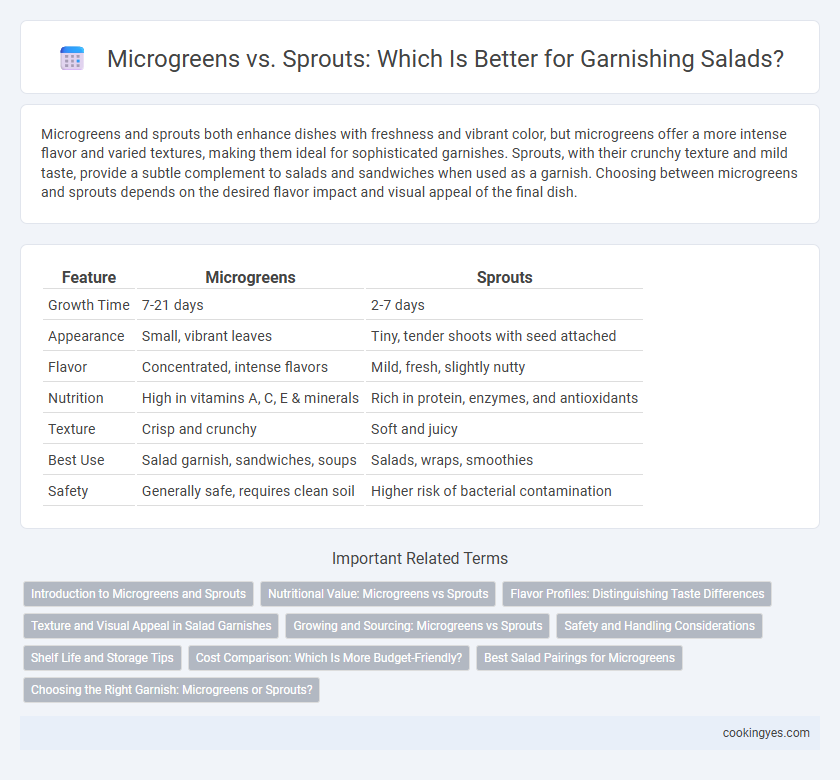Microgreens and sprouts both enhance dishes with freshness and vibrant color, but microgreens offer a more intense flavor and varied textures, making them ideal for sophisticated garnishes. Sprouts, with their crunchy texture and mild taste, provide a subtle complement to salads and sandwiches when used as a garnish. Choosing between microgreens and sprouts depends on the desired flavor impact and visual appeal of the final dish.
Table of Comparison
| Feature | Microgreens | Sprouts |
|---|---|---|
| Growth Time | 7-21 days | 2-7 days |
| Appearance | Small, vibrant leaves | Tiny, tender shoots with seed attached |
| Flavor | Concentrated, intense flavors | Mild, fresh, slightly nutty |
| Nutrition | High in vitamins A, C, E & minerals | Rich in protein, enzymes, and antioxidants |
| Texture | Crisp and crunchy | Soft and juicy |
| Best Use | Salad garnish, sandwiches, soups | Salads, wraps, smoothies |
| Safety | Generally safe, requires clean soil | Higher risk of bacterial contamination |
Introduction to Microgreens and Sprouts
Microgreens are young vegetable greens harvested just after the first true leaves develop, offering intense flavors and vibrant colors that enhance salad presentations. Sprouts, on the other hand, are germinated seeds consumed at an earlier growth stage, rich in enzymes and nutrients but with a milder texture. Comparing microgreens and sprouts for garnish highlights microgreens' superior visual appeal and concentrated taste profile, making them ideal for elevating salad aesthetics and flavor complexity.
Nutritional Value: Microgreens vs Sprouts
Microgreens contain higher concentrations of vitamins such as A, C, and K, along with antioxidants compared to sprouts, delivering superior nutritional benefits per serving. Sprouts, while rich in enzymes and digestible proteins, generally provide lower vitamin density but contribute valuable minerals like iron and magnesium. Choosing microgreens as a garnish enhances nutrient intake efficiently, making them ideal for health-conscious culinary presentations.
Flavor Profiles: Distinguishing Taste Differences
Microgreens offer a more intense and concentrated flavor compared to sprouts, with varieties like arugula microgreens delivering a peppery bite and cilantro microgreens providing a fresh, citrusy note. Sprouts typically have a milder, crunchier texture and subtle taste, such as alfalfa sprouts which are nutty and slightly grassy. Choosing between microgreens and sprouts for garnish depends on whether a bold, vibrant flavor or a delicate, fresh touch is desired.
Texture and Visual Appeal in Salad Garnishes
Microgreens offer a delicate crispness and vibrant colors that enhance the texture and visual appeal of salad garnishes with their tender leaves and varied hues. Sprouts provide a softer, juicier texture and a subtle sheen, adding freshness while creating a more understated aesthetic. Choosing microgreens emphasizes intricate leaf patterns and crunch, whereas sprouts contribute a minimalist look and a gentle mouthfeel to salads.
Growing and Sourcing: Microgreens vs Sprouts
Microgreens are harvested after 7-21 days of growth when the first true leaves develop, requiring soil or a growing medium, which enhances nutrient density and flavor complexity, making them ideal for gourmet garnishes. Sprouts are grown in water for just 3-7 days before harvesting, providing a crunchy texture but with a higher risk of bacterial contamination due to moist conditions during growth. Sourcing microgreens often involves local farms or specialty growers ensuring quality and sustainability, while sprouts are commonly produced on a smaller scale or homegrown with simple setups.
Safety and Handling Considerations
Microgreens require careful washing to reduce bacterial contamination risks, while sprouts have a higher likelihood of harboring harmful pathogens due to their moist growing conditions. Proper refrigeration and consuming microgreens promptly ensures freshness and safety for garnish use. Handling sprouts with caution, including thorough cooking, is recommended to minimize foodborne illness associated with raw consumption.
Shelf Life and Storage Tips
Microgreens have a longer shelf life than sprouts, often lasting up to a week when stored properly in the refrigerator at 32-40degF with high humidity. Sprouts are more perishable, typically maintaining freshness for only 2-3 days, and require rinsing and drying before refrigeration to prevent bacterial growth. Storing microgreens in a breathable container lined with paper towels helps absorb excess moisture, while sprouts should be kept in a sealed container with ventilation to balance moisture and airflow.
Cost Comparison: Which Is More Budget-Friendly?
Microgreens typically cost more than sprouts due to their longer growth period and higher nutrient density, making sprouts a more budget-friendly choice for garnishing salads. Sprouts, grown in just a few days, provide fresh, crunchy texture at a lower price point, ideal for cost-conscious consumers. Choosing sprouts over microgreens can reduce garnish expenses by up to 50% while still enhancing the visual appeal and nutritional value of salads.
Best Salad Pairings for Microgreens
Microgreens, rich in flavor and nutrients, pair exceptionally well with fresh salad greens like arugula, spinach, and mixed greens, enhancing both texture and taste. Their delicate leaves of sunflower, radish, or pea shoots add a vibrant, colorful garnish that complements crisp cucumbers, cherry tomatoes, and avocado slices. Using microgreens as a salad garnish elevates the dish with a burst of nutrition and visually appealing freshness unmatched by sprouts.
Choosing the Right Garnish: Microgreens or Sprouts?
Microgreens offer vibrant colors and concentrated flavors, making them ideal for elegant salad garnishes that enhance visual appeal and taste. Sprouts, with their crunchy texture and mild, fresh flavor, add a crisp bite while boosting nutritional value. Choosing the right garnish depends on the desired texture, flavor intensity, and presentation style of the salad.
Microgreens vs Sprouts for Garnish Infographic

 cookingyes.com
cookingyes.com